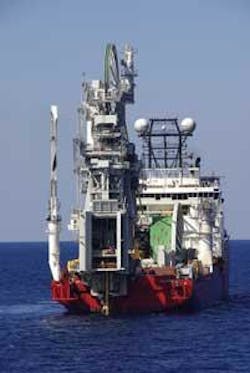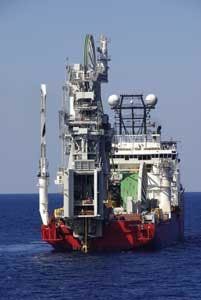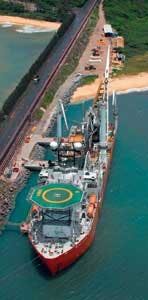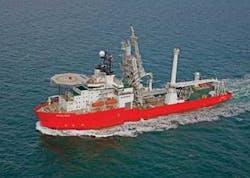Subsea contractor strengthens deepwater flexible/rigid lay capability
Julie Gauld - Subsea 7
Subsea 7 is investing more than $1.2 billion in its vessel fleet and equipment with eight new vessels scheduled to join the fleet between 2007 and 2010. These will increase the company’s overall capacity and are strategically targeted with new technology and capability to serve deepwater and ultra deepwater markets globally.
To date the company has taken delivery of theSeven Oceans, the Normand Seven, and in June 2008, the Seven Seas. Among them they offer an increased capability to install rigid and flexible flowlines, pipe-in-pipe lines, steel catenary risers (SCRs), free-standing risers including single line offset riser (SLOR) and concentric offset riser (COR) type systems, flexible risers, umbilical and steel tube umbilicals, and all associated spool pieces, flying leads, jumpers, and other construction work.
Seven Oceans
TheSeven Oceans, delivered July 2007, is a rigid reeled pipelay vessel designed to operate in deepwater globally. The 157-m (516-ft) long vessel is fitted with a main reel capable of carrying 3,500 tons (3,175 metric tons) of rigid steel pipe; a pipelay tensioner with a 400-metric ton (441-ton) capacity; a 400-metric ton capacity deepwater crane; and an ability to lay pipe in water depths of up to 3,000 m (9,842 ft). A lay ramp system is permanently installed for deployment of a range of rigid products with diameters ranging from six to 16 in. (15.2-40.6 cm). The vessel can accommodate up to 120 personnel.
Using the reel lay method, pipe is welded onshore, coated, and then loaded onto a storage reel on the vessel. The pipe is then plastically deformed around the hub of the reel.
When the pipe is laid offshore, it is pulled off the reel over an aligner at the top of the lay ramp and passed through a straightening system. This process of lowering the pipe to the seabed is controlled by a linear tensioner which grips hold of the pipe as it passes. The main benefit of this approach is that much of the welding and coating is undertaken onshore, where vessel motion, deck space, and weather factors are not the constraints they can be at sea.
An innovative Pipeline End Terminations (PLET) handling system onboard is designed to make the process of handling and installing small manifolds into the pipeline safer and more efficient.Seven Oceans is fitted with deck rails for PLET storage and transfer, a PLET manipulator for elevating PLETs into the ramp, and a PLET line-up tool in the ramp. The PLET manipulator is designed to avoid the use of handling PLETs by crane at sea, and can bring a PLET to the ramp when the ramp is in any position.
Seven Oceans completed its first major deepwater installation project last November, less than 30 months after the company announced its plan to build the vessel. This was the in-field installation of two 7-km (4.4-mi), 7-in. (17.8-cm) pipelines, including SCRs, for Chevron’s Blind Faith development in the Gulf of Mexico
After arriving in Brazil in late 2007, the vessel completed its first job in the region, installing a section of the oil line that will tie inP-51 to PRA 1, as part of the PDEG project for Petrobras. This 12-in. (30.5-cm) rigid pipeline is around 22-km (13.7-mi) long and was installed in the Campos basin in about 1,250 m (4,101 ft) water depth.
Following completion of this work, the vessel moved to Petrobras’ Hybrid project. It set 19 separate flowlines totaling 132 km (82 mi), in water depths ranging from 200 to 1,600 m (656 to 5,249 ft) in the Campos, Santos, and Espirito Santos basins. Work began in January 2008 was completed in early May, and included a 6-km (3.7-mi) section of 12-in. (30.5-cm) gas export line for Petrobras’ Camarupim project. Following completion in Brazil, the vessel headed to Africa to begin work on Chevron’s Tombua Landana development in block 14, offshore Angola.
Seven Seas
TheSeven Seas has been designed to carry out vertical lay operations through a conventional moonpool for flexible pipe and umbilicals.
The pipe can be stored in two 16-m (52-ft) external diameter, 1,250-ton (1,134-metric ton) underdeck carousels in the main hold or by using 250-300-ton (227-272-metric ton) reels on deck or on a 24-m (78.7-ft), 3,000-ton (2,721-metric ton) deck carousel. The vessel has a deck area of 1,750 sq m (18,837 sq ft), with a load capacity of 10 tons/sq m. It also has the ability to lay rigid pipe in J-Lay mode, in response to increasing demand for this method in deepwater fields.
To minimize the effect of vessel motion, the multipurpose pipelay tower is located near the center of the vessel, amidships and immediately forward of the moonpool and aft of the ROV hangar.
For running flexible pipe, the tower is equipped with two retractable tensioners and port and starboard sets of aligner chutes. These are supported by an abandonment and recovery system and a 20-ton (18.1-metric ton) knuckle-boom crane. The lower tensioner is rated at 260 tons (236 metric tons) in flexible pipe mode or 400 tons (363 metric tons) when working with rigid pipe. The upper tensioner is rated at 170 tons (154 metric tons) in flexible pipe mode. When performing J-Lay operations, a moveable module is introduced, which incorporates pipe-line up tools and an enclosed welding station.
A dedicated pipe coating station in the upper part of the moonpool area can be arranged to support the J-Lay process. This allows field joint coating to be applied simultaneously with the welding. The line is then lowered through the moonpool. The 7.5 x 8.5 m (24.6 x 27.9 ft) moonpool is large enough to allow sufficient clearance for PLET deployment when the pipelaying tower is angled in rigid pipeline J-Lay mode.
When the moonpool’s deck level sliding hatches close they can support loads of more than 600 tons (544 metric tons). During transit, the moonpool also can be partially closed at the bottom using a hinged door in order to reduce wave motion and resistance in transit, while also enabling wave-dampening.
TheSeven Seas is also equipped for the installation of SLOR and COR type systems, free-standing riser design arrangements that use either a single or pipe-in-pipe configuration. These risers are supported by a combination of air cans and a buoyant material.
The vessel has a 400-ton (363-metric ton) main crane located amidships on the port side, which allows it to service the moonpool and tower as well as the aft deck. It also has two over-the-side launched ROVs installed, which can work in 3,000 m water depth and are housed in a dedicated hangar. The vessel can therefore operate independently of dedicated survey ships. Other equipment onboard includes a Veripos DGPS system, a Simrad Seapath DGPS-based heading system, a Simrad EM1002 multibeam echo sounder, and an RDI Workhorse current sensor.
The vessel is 153.24 m (503 ft) long, with a breadth of 28.4 m (93.2 ft), and a design draught of 7.5 m (24.6 ft). It is powered by six 3,360-kW (4,505 hp) generators feeding three Wartsila 2,950-kW (3,956-hp) stern azimuth thrusters, two 2,400-kW (3,218-hp) retractable bow thrusters, and a 2,200-kW (2,950-hp) bow tunnel thruster, giving a total thruster power of 15,850 kW (21,255 hp) and a speed of 13 knots.
TheSeven Seas’first installation project will take place this summer for StatoilHydro’s Yttergryta field in the Norwegian North Sea. As part of the StatoilHydro frame agreement, it will perform construction work including installation of subsea structures: a 140-ton (127-metric ton) pipeline end manifold (PLEM), and a 25-ton (22.7-metric ton) flow base, piggy-back lay of umbilical/MEG line, and installation of three spools before transiting to Brazil to begin work on the BC-10 development in the Campos basin.
Further investments
At the end of April, Subsea 7 announced a $190-million investment in a further newbuild pipelay and construction vessel, which will have an overall length of 133 m (436 ft) and a beam of 24 m (78.7 ft). It will be equipped with a pipelay suite for installing flexible flowlines and umbilicals, including a Vertical Lay System tower and twin underdeck carousels, a 250-ton crane, and twin 3,000 m-rated ROVs. The ship is expected to be delivered in the 3Q 2010.
In May the company also announced that it had acquired theSkandi Navica pipelay and construction vessel. This has been under charter with Subsea 7 for eight years and has a track record of pipelay installation projects across the globe.
Built in 1999, the vessel will be renamedSeven Navica and will continue to operate as a rigid pipelay ship within the Subsea 7 worldwide vessel fleet. It has an overall length of 108 m (354 ft) and a beam of 22 m (72.2 ft). Capable of operating in water depths of up to 2,000 m (6,561 ft), it has pipelay capability for installing both rigid and flexible flowlines and umbilicals, with one deck-mounted storage and deployment reel with capacity for pipe diameters of up to 16 in. (40.6 cm), and a total weight of 2,200 tons (1,996 metric tons).



